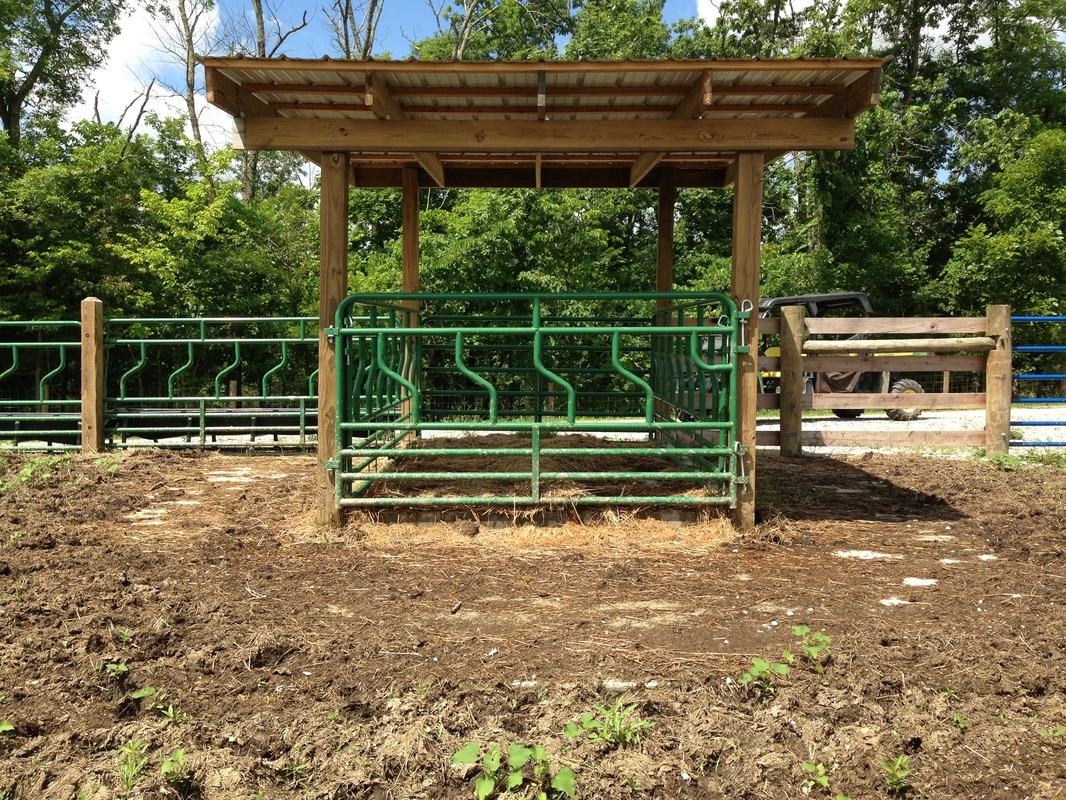|
We recently held two field days at the ESF about the Fenceline Feeding System. The first one in April had 90 people attend and the second one on May 9th had another 55 producers. There has been a lot of interest about this system, so I wanted to share how the first season of using these feeders turned out. In general there was no preference by the cattle as to which feeder they preferred. The only time you could notice a difference was if it had been raining, they like to eat the dry hay that was under the roofed structure. Other than that, they tended to eat the best hay first, regardless of which feeder it was in. I will start by saying that we fed 55 pairs on this structure for about 6 weeks, most during March and April, which this year was dry for that time of the year. First lets look at the hay remaining in each structure and the cattle footing to see how it held up. The first structure is the roofed feeder. This feeder would tend to have the least amount of waste simply because the hay stayed dry and they would eat all of it that they could reach. The manure load on this structure seemed more because it was a concrete surface and it wasn't incorporating down into the gravel aggregate like on some of the others. Over all, this was a very good feeder that would work good if you don't have a lot of cattle feeding at once and the hay stays in the feeder for longer periods of time as the roof keeps it dry and the cattle eat it all. The next feeder is identical to the first one other than it does not have a roof over it. It has the prefab feeding panels and the concrete apron where the cattle stand. This was my preferred feeder simply from a low maintenance standpoint. Over time this feeder appears to need less upkeep than the other feeders. If you feed your hay fast enough there is no need for the roof which is one less item to maintain. The next feeder has the wooden feed panels and is slightly wider than the first two feeders. This feeder also has the geogrid flooring for the cattle instead of concrete. The geogrid seemed to hold up very well the first year with no visible signs of needing maintenance. The wider feeder leaves a little more hay in the middle of the feeder than the others, but was not an issue with the cattle being able to reach the hay. The next feeder has the same wooden feeding panels, but the footing for the cattle is geotextile fabric and gravel. There is also gravel inside the feeder where the bale sits. All the other feeders so far have had the bales sitting on concrete. This feeder seemed to function the same as the others, but it had some slight indentations in the gravel where the cattle's front feet stood during use. This will cause some added maintenance over time compared to the other units, but the functionality seemed the same. The last feeder was 2/3rds of a hay ring. This seemed to work fine, although with a tighter clearance for the bale, the cattle tended to waste a little more hay on the ground. With the other feeders being wider, the cattle have to stick their heads into the feeder to get to the hay, therefore dropping hay back into the feeder while they were eating. With the hay ring style they can reach the hay without having to reach in very far and they tend to drop the hay on the ground where they are standing thus wasting more. These photos all show a little more hay left in the feeders than during peak use. At the end of feeding hay the cattle were starting to pick grass in the fields and didn't want to clean the hay all the way up like they did in the winter. Here is a photo that shows a more accurate representation of the amount of hay that they could not reach in the center of the feeders. This was not a problem however. We simply slid the next bale of hay in, pushing the uneaten hay to the back of the feeder where they could reach it. As you can see, there was only about 12-15 inches that they could not reach. Overall I would highly recommend a hay feeding system like this to producers. Being able to feed hay without having to open gates and go into the field is a huge help when feeding by yourself. It also saves tearing up your fields with the tractor during those wet, muddy months. Locating this feeder close to the hay source also saves a lot of time. And one added benefit that I had not planned on was the ease of checking the cattle. They were usually all around the feeders so I didn't even have to go into the field to check them unless one was missing. All in all it saved a lot of time and labor and it preserved the forages out in the pasture. It is a good system and I want to thank Dr. Higgins for allowing us to implement it at Eden Shale.
|
Archives
June 2024
Categories
All
Welcome |
CONTACT US |
EMAIL SIGN UP |
|
Eden Shale Farm
245 Eden Shale Rd. Office: (859) 278-0899 Owenton, KY 40359 Fax: (859) 260-2060 © 2021 Kentucky Beef Network, LLC.. All rights reserved.
|
Receive our blog updates
|




















 RSS Feed
RSS Feed
